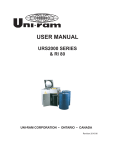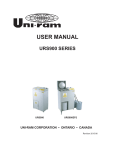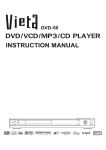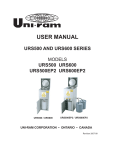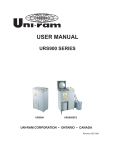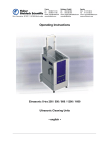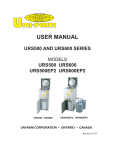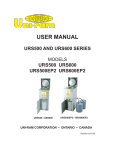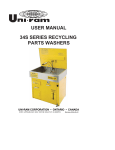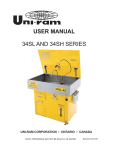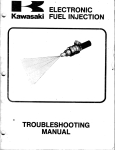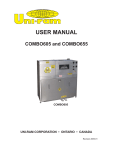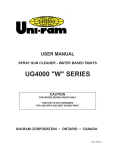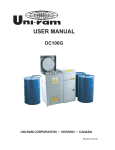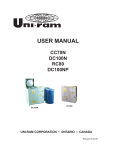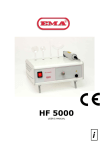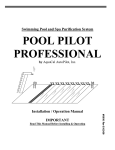Download MANUAL_USER - DB100N.indd - Uni
Transcript
USER MANUAL DB100N UNI-RAM CORPORATION • ONTARIO • CANADA Revision 2012-03 MANUAL - SOLVENT RECYCLERS - DB100N Revised 2012-03 CONTENTS INTRODUCTION ................................................................................................................................... 3 SAFETY APPROVALS ........................................................................................................................... 3 CAUTIONS AND WARNINGS ............................................................................................................... 3 FEATURES AND SPECIFICATIONS .................................................................................................... 4 SAFETY FEATURES ............................................................................................................................ 4 PREPARATION AND SETUP .............................................................................................................. 5 CONSUMABLES AND ACCESSORIES ............................................................................................. 5 LOCATION AND CONNECTION .........................................................................................................5-6 SOLVENT REQUIREMENTS AND DEFINITIONS ................................................................................ 6 OPERATING PROCEDURES ........................................................................................................... 7-11 THEORY OF OPERATION ................................................................................................................. 12 TROUBLESHOOTING GUIDE ........................................................................................................... 13-14 TEST MODE and ERROR MESSAGES ............................................................................................ 14-15 SERVICE PROCEDURES INCLUDING 6-MONTH MAINTENANCE ................................................. 16-17 REPLACEMENT PARTS .................................................................................................................... 18-20 WARRANTY ....................................................................................................................................... 21 2 MANUAL - SOLVENT RECYCLERS - DB100N Revised 2012-03 INTRODUCTION Uni-ram holds many patents on designs used in its innovative products. Every machine is tested for compliance with Quality Assurance standards. Follow the instructions on preparation, use and operation to operate this machine safely and effectively. Ensure that this manual is readily available to the operator at all times. If you have any questions about the operation of this machine, contact: North America: Uni-ram Technical Service 1-800-417- 9133 Other Continents: Contact Your Supplier SAFETY APPROVALS This unit is certified under UL standards U2208 and CSA standards C22.2 No. 30 and No. 88 by ETL for use in non-hazardous locations as well as for use in hazardous locations Class 1, Division 1, Group D – T2A and and Class 1, Division 2, Group D -T2A. CAUTIONS AND WARNINGS • • • • • • • • The operator should wear protective clothing in accordance with local safety and environmental regulations, with a minimum of face goggles and gloves along with an apron and respirator if required. Always disconnect the power source before performing maintenance. DO NOT SMOKE OR USE THIS EQUIPMENT NEAR A POTENTIAL SOURCE OF IGNITION SUCH AS SPARKS OR AN OPEN FLAME. This unit must be located at least 6 feet (1.8 m) from all potential sources of ignition including electrical receptacles, switches, pilot lights, fixtures and contacts when installed in a non - hazardous locations. The ambient temperature must be between 5°C (41°F) to 35°C (95°F). DO NOT RECYCLE NITROCELLULOSE WHICH IS EXTREMELY VOLATILE. IT AUTOMATICALLY IGNITES AT 135°C TO 166°C (275°F TO 330°F). Do not install, operate or maintain this equipment where the auto ignition temperature of the solvent is lower than 250°C (482°F). Do not install, operate or maintain this equipment where the auto ignition temperature of the hazardous atmosphere(s) is lower than 250°C (482°F). Solvents that are recycled can be flammable. Establish and follow safe practices to store and handle solvents. Units must be installed by a qualified electrician and according to applicable laws. 3 MANUAL - SOLVENT RECYCLERS - DB100N Revised 2012-03 FEATURES AND SPECIFICATIONS All Uni-ram Solvent Recyclers feature rapid-start direct electric heating of solvent and a short cooldown time due to high-efficiency condensers and air cooling with a motor driven fan. VOLTAGE (V) SINGLE PHASE 220/240* BRANCH CIRCUIT AMPS MAX TEMPERATURE SET POINT TIME TO RECYCLE TANK CAPACITY LID GASKET SHIPPING DIMENSIONS (WDH”) WEIGHT (LB/KG) 20 240°C 8-10 HOURS 20 US GAL (80L) VITON 47 X 27 X 50 450/205 *Note on voltage: Operating the unit at a lower voltage (eg: 208V) may result in reduced performance. This recycler is intended for use with a waste that is liquid after recycling and will drain from the tank when the the operator opens the ball valve. This recycler is not intended for use with a bag if the boiling point of the solvent - waste combination is above 200°C. Safety Features: • Certified to UL standards U2208 and CSA standards C22.2 No. 30 and No. 88 by ETL. Approved for use in non hazardous locations as well as approved for use in hazardous locations Class 1, Division 1, Group D and Class 1, Division 2, Group D. • Explosion proof construction and intrinsically safe electric circuitry. • Computer controlled with many built-in safety programs including temperature control of all critical points including tank, condenser and fan motor. Power is cut when the temperature at any of these points rises above a pre-set level. Operation also terminates when other abnormal conditions exist (eg: boiling does not start on time or the distillation process takes too long). • Automatic pressure relief lid system prevents pressure in the Distillation Tank from exceeding 0.5 to 1.0 psi. (0.035 to 0.070 kglcm2). • Self Diagnostic error messages are displayed on the Display Panel. • Dual lid cover system. • Compact, enclosed cabinet for safe storage of the Solvent Receiving Container inside the cabinet. Operating Features: • Rapid-start due to direct electric heating of solvent, no diathermic oil to change. • Short cool-down time. High efficiency condenser, air cooled with motor driven fan. Warranty: 1 year on unit, 2 years on pump. 4 MANUAL - SOLVENT RECYCLERS - DB100N Revised 2012-03 PREPARATION AND SETUP: • • • • • Carefully inspect the shipping crate for any sign of transport damage. Carefully remove the unit from the shipping crate. Check the unit for damage. Report any transport damage immediately to the carrier and your vendor. Initiate a freight claim with the carrier. The manufacturer is not responsible for freight damage. Check the Accessory Kit for the parts listed below. If any parts are missing, contact your supplier. Additional consumables and accessories are also listed. Level the unit using the adjustable feet and install the Door Handle when applicable. ACCESSORY KIT CONTENTS Manual Viton Lid Gasket (965-2150V) LOCATION AND CONNECTION: This unit is certified for use in non-hazardous locations and hazardous locations Class 1, Division 1 Group D and Class 1, Division 2, Group D. • Non-hazardous Location: If using a non-hazardous plug, the unit must be located outside of a hazardous location. In a non-hazardous location, we recommend that you use a receptacle located a minimum of 6 feet (185 cm) from the unit and a minimum of 30” (80 cm) from the floor. We also recommend that the unit be located at least 6 feet from any potential source of ignition such as electrical receptacles, switches, pilot lights, fixtures, contacts and similar equipment. To clarify the definition of an appropriate location, contact your local authority. This unit must be connected to the power supply only by a qualified electrician in accordance with the National Electrical Code. • Hazardous Location: In hazardous locations (Class 1, Division 1, Group D and Class 1, Division 2, Group D), the power cord must be connected to the main power supply only by a qualified electrician, in accordance with the National Electrical Code. This equipment must be properly connected to an explosion proof outlet (receptacle or hard wired). Select a Location That Meets EACH AND EVERY Requirement, Described Below. 1) Comply with the instructions in the section: CAUTIONS AND WARNINGS. 2) Position the solvent recycler in a location so that there is at least 16 inches (40 cm) of space all around the unit. Ensure that the safety lid and door freely opens fully and a container for receiving the distilled solvent can freely move in and out of the cabinet. The unit must be in a location where people or equipment cannot disturb the cable or connection. The cord must be connected directly to the main power supply; an extension cord cannot be used. 3) Connect the unit to a dedicated, single phase 220/240V, 20 Amp branch circuit. 5 MANUAL - SOLVENT RECYCLERS - DB100N Revised 2012-03 WASTE REQUIREMENTS The waste after recycling is liquid like and will drain from the recycler tank when the operator opens the ball valve. To encourage draining, the waste may be warmed up by turning on the recycler for 10 minutes before opening the drain valve. SOLVENT REQUIREMENTS This unit recycles flammable solvents and combustible solvents. Flammable solvents include lacquer thinner, paint thinner, acetone and other paint diluents. Flammable Solvents have a flash point below 38.7°C (100°F). These solvents are commonly used in the industry as a cleaning solvent, or as a paint diluent. Dirty solvent to be distilled must meet each requirement described below. The MSDS, material solvent data sheet, provides data on the properties of the virgin solvent. 1) The BP (Boiling Point) of the dirty solvent must be less than 240°C (464°F). BP increases with greater contamination. 2) The auto-ignition temperature of the solvent to be distilled must be higher than 250°C (482°F) for safe operation. Do not recycle Nitrocellulose. The auto ignition temperature is 135°C (275°F). Notes: • Recycle recently contaminated solvent only. Standing solvent can become acidic over time. • To avoid “FISH EYE” problems, do not recycle both paint dilutents and parts washer solvent in the same unit. Waste Residue The waste residue of some paints will remain moist after recycling due to the composition of the paint itself. A dry waste residue is not guaranteed. Definitions Flash Point: The lowest temperature at which the vapor of a solvent can be made to ignite momentarily in air. Auto-ignition Temperature (often referred to as “ignition Temperature” or “Ignition Point”): The temperature at which solvent ignites by itself. 6 MANUAL - SOLVENT RECYCLERS - DB100N Revised 2012-03 OPERATING PROCEDURES Wear protective clothing in accordance with local safety and environmental regulations. Use face goggles and gloves as a minimum. Use an apron and respirator if required. Summary of Operating Steps: 1) Open the Tank Lid and Safety Cover 2) Install the Receiving Container, the Transfer Hoses and the air Supply 3) Transfer Solvent to the Recycler Tank 4) Check distillation conditions and change, if necessary, using SETUP MODE 5) Recycling 6) Finish Recycling 7) Transfer clean solvent 8) Remove waste debris 9) Clean Distillation Tank and Lid Surface 10) Inspect Lid Gasket, Remove and Replace if necessary Each Step is described in detail below. 1) Open the Tank Lid and Safety Cover • • • Open the safety cover. Open the inner lid by releasing the Lid Clamp. Make sure that Tank is empty. PULL BACK ON HANDLE TO RELEASE LID CLAMP. PUSH DOWN TO LOCK LID CLAMP HANDLE 7 MANUAL - SOLVENT RECYCLERS - DB100N Revised 2012-03 2) Install the Receiving Container, the Transfer Hoses and the air Supply Receiving Container • • A 20 US Gal (80 liter) container (or larger) must be used to receive the distilled solvent. Make sure the Solvent Outlet Tube is properly inserted into the top opening of the Receiving Container. When placing the Solvent Receiving Container, make sure the alligator clamp of the Grounding Strap is firmly connected to the exposed metal surface of the container. Air Supply • • • This model is equipped with an air operated Dual Diaphragm pump and requires a supply of clean, dry air of at least 85 PSI (6 kg/cm2). Connect the air supply to the Air Inlet Fitting (1/4” NPT Female Threads) located on the back panel of the unit. Make sure that there are no leakages at the connection. Make sure that the air is free of dust, rust and other contaminants. Use a Moisture Filter (not supplied), if necessary. These models are equipped with a Pressure Regulator pre-set to 85 PSI (6 kg/cm2). Hose Connections • • • • • • Place the drum/container with the dirty solvent to be distilled close to the unit. Connect the Solvent In Hose to the Solvent In port of the unit and insert the other end (with the Tank Filler Suction Pipe) into the drum/container. Connect the alligator clamp at the end of the Ground Strap to the container with dirty solvent. Place the drum/container for the clean solvent close to the unit. Connect the Solvent Out Hose to the Solvent Out port of the unit and insert the other end with the Outlet Tube into the drum/container. The Outlet Tube must extend below the rim of the pail to prevent solvent spillage. If the pail is metal, connect the alligator clamp of the Ground wire to the rim of the drum/container. 8 MANUAL - SOLVENT RECYCLERS - DB100N Revised 2012-03 3) Transfer Solvent to the Recycler Tank • • • • • • • Turn the Handle of the Filler Valve counter-clockwise to open the filling passage; after a few seconds, dirty solvent will start flowing into the Distillation Tank. After the filling process has been completed, turn the Handle of the Filler Valve clockwise Check that the sealing area around the top of the Tank is clean and damage free. Close the Tank Lid. Making sure that the Lid is firmly seated to avoid leakage. Secure the Lid Clamp. Close the Safety Cover. 4) Check distillation conditions and change, if necessary, using SETUP MODE. Estimate Boiling Point Add 40°C (100°F) to the boiling point of the pure solvent as shown on the MSDS (Material Safety Data Sheet) or another reliable source. Recycle more often The boiling point of the waste solvent mixture increases as it gets dirtier. To reduce the boiling point, recycle more often. Minimize Temperature Set Point After recycling there will be a small amount of solvent, about 1/8 US gal (500 ml), remaining in the distillation tank due to condensation. Select the lowest Temperature Set Point that recycles the solvent to this level. If all the settings are acceptable, press START to begin distillation. To change settings, enter Setup Mode 9 MANUAL - SOLVENT RECYCLERS - DB100N Revised 2012-03 SETUP To change settings, enter Setup Mode: while pressing SETUP, press START. “SET-UP MODE” is displayed. STEP SETTING 1 2 ADJUST ACCEPT DESCRIPTION SET-PT = XXX°C (°F) POWER = XXX% + OR - + OR - OK To choose a SET POINT, look up the solvent’s BP (boiling point (MSDS, online etc) and add about 40°C (100°F). OK If boiling is too vigorous due to one or more of the following conditions, decrease POWER by one increment or more. • vapour leaks at the Lid Gasket • recycled solvent comes out too hot • waste material is carried into the recycled solvent Otherwise, use 100%. 3 SHUT-OFF = AUTO** + OR - OK If too much solvent remains in the Distillation Tank after recycling and the problems in the Troublshooting Guide have been ruled out, over-ride the AUTO SHUT-OFF and manually select a heating time (eg: 4 hours). The heater will stay on for this amount of time and then cooling will begin. 4 BAKE TIME = XXM + OR - OK Only available when SHUT-OFF = AUTO. Increase if residue (puck) is too wet. **WARNING: SHUT-OFF TIME MUST NOT BE SET TO MORE THAN 12 HOURS To change the temperature units from °C to °F, from the Ready mode, press and hold the + and keys together for 2 seconds. 5) Recycling On first power up and on RESET, the Display Panel shows the Software Version, then: “READY S.P. = XXX°C” (S.P. = SET POINT). When Setup is complete and START has been pressed, the “HEAT” light comes on and the recyling process begins. During the boiling phase, 3 temperatures will alternate on the Display: “SET-PT”, “TANK” and “VAPOR EX.” When the boiling phase is complete, “COOLING” will be displayed. Note: the fan will still be running; this is normal as it continues to run until the temperatue drops below 50°C. To cancel the cycle, press the “STOP” key. 6) Finish Recycling CAUTION: DO NOT OPEN LID UNTIL COOLING IS COMPLETE The clean, recycled solvent is available for use when the display shows “READY S.P. = XXX°C”. After the clean solvent is transferred, the unit will be ready for another cycle. 7) Transfer Clean Solvent a) For models without the Solvent Transfer System: remove the pail and replace with an empty one. b) For models with the Solvent Transfer System: turn the Transfer Timer knob clockwise fully. The clean solvent will flow out of the Solvent Receiving Pail into a free-standing, external container. The transfer will stop when the timer runs out. 8) Drain Debris: Remove the Retainer Ring and slowly pull the Liner Bag containing the debris out of the distillation tank in a way that the Liner Bag does not break. Dispose of the debris in accordance with local regulations. 10 MANUAL - SOLVENT RECYCLERS - DB100N Revised 2012-03 9) Clean Distillation Tank and Lid Surface Distillation Tank: Wipe inside the Tank with a cloth. Remove any remaining debris from the Distillation Tank using if necessary, plastic or wooden tools (not supplied). Do not clean with abrasive or hard metal instruments that can damage the tank. The warranty does not cover such damage. Note: There will be about 1/8 Gal (500 ml) of solvent remaining in the Distillation Tank after recycling due to condensation. This solvent, If left in the tank, can cause corrosion. Dirt and debris left in the tank can prevent full heat from reaching the dirty solvent during recycling. Caution: Inspect your tank after each batch for wear. If there is excessive deterioration, call a Service Technician and replace the tank. Lid Surface: Use a cloth. Dry and clean the lid and the top of tank where the the Lid Gasket sits to extend the life of the Lid Gasket and prevent leakage. Avoid rotating the lid during cleaning. 10) Inspect Lid Gasket, Remove and Replace if necessary as required Inspect the Lid Gasket for shrinking, hardness and cuts. The Lid Gasket is a wear item as it is exposed to high temperature and solvent vapor during distillation. Damage to the lid gasket will cause solvent to leak. To remove, open the Safety Cover and Tank Lid. Lift out the old gasket by hand and clean the cavity with a cloth. Rub solvent or soapy water on the gasket to make insertion easier, then insert in cavity. Insert the gasket at “12:00, 3:00, 6:00, 9:00” first, then work gasket into cavatiy between these points. Make sure that the gasket is properly and firmly fitted in place. CAUTION: AN IMPROPERLY INSTALLED GASKET WILL CAUSE SOLVENT TO LEAK. Note: Keep a spare in stock. One extra is included with the unit. 11 MANUAL - SOLVENT RECYCLERS - DB100N Revised 2012-03 THEORY OF OPERATION - DISTILLATION PROCESS Waste solvent consists of the original solvent plus liquid and solid materials picked up during use of the solvent. Recycling separates the original solvent from the waste materials. During the recycling process, the distillation tank fills with dirty solvent and the heating element heats the mixture. The solvent mixture boils and the vapour passes through a cooling condenser where purified, clean solvent, ready for use condenses out. Waste materials in the dirty solvent boil at a temperature substantially above the Temperature Set Point so they remain in the distillation tank for disposal. Solvent Recycling Vapour Outlet tube (vapor moves to cooling condenser from distillation tank) Distillation Tank Condenser (cools vapor to a liquid) Heating Element Receiving Pail (contains clean, recycled solvent) Distillation Cycle 1. 2. 3. 4. 5. Heating starts, temperatue rises Vapourization starts Vapourization ends, AUTO SHUT-OFF / BAKE TIME starts (see SETUP) Baking finishes, cooling begins Cooling is complete Temp SET POINT 4 2 3 5 1 TEMP TIME 12 MANUAL - SOLVENT RECYCLERS - DB100N Revised 2012-03 TROUBLE SHOOTING GUIDE Carry out each action step until a solution is found. If the recommended actions do not solve the problem call Uni-ram Service in North America or contact a qualified Service Technician. Caution: Disconnect the power supply before conducting maintenance or service. PROBLEM CAUSE ACTION STEPS Unit is plugged in, power light is off, Display Panel is not working. Power is not getting to the unit. Reset breaker or replace fuse. If power is still not getting to the unit, call a Qualified Service Technician. Ensure that the unit is the only device on a circuit with sufficient capacity. Unit is plugged in, power light is on, Display Panel is not working. Power board or computer board not functioning. Call Uni-ram Service Recycled solvent is not clear 1) The solvent is react- 1) Run SETUP and lower the Termperature ing chemically. Set Point. Dirty solvent remains in Distillation Tank after recycling 2) The solvent flow path is dirty. One cause is overfilling the distillation tank. 2) To clean the path, follow Service Procedure 2 and then recycle 3 gal of clean solvent. 3) Orange colour due to rust in receiving pail. 3) Place a jar under outlet tube and capture some solvent. If the solvent is clear, replace the pail with a non-corrosive one. 4) Milky colour due to presence of water. 4) Eliminate source of water in solvent. 1) Poor heat transfer due to dirt and debris left in the tank. 1) Clean the tank, recycle with pure solvent to test. If successfull, the problem is due to a dirty tank, debris left in the tank or the solvent is too contaminated. Adjust accordingly. Follow Operating Procedures closely. If the level of contamination is too high, recycle more often. 2) Boiling point of solvent is above Temperature Set Point. 2) Run SETUP, raise the Temperature Set Point and repeat the recycling operation. The Temperature Set Point should be the boiling point of pure solvent (as determined from the MSDS or other source) plus 40°C (104°F) to allow for contamination. If the boiing point is above 240°C (464°F) - the maximum Temperature Set Point for your model - DIRTY SOLVENT CANNOT BE RECYCLED in this unit. 3) The Auto Shut Off system is shutting the unit off too soon. 3) Run SETUP and over-ride the auto SHUT-OFF. Select a time period long enough to recycle the solvent. The heater will stay on for this duration. Repeat the recycling operation. Note: 1/8 Gal (500 ml) of recycled solvent is expected due to condensation. 13 MANUAL - SOLVENT RECYCLERS - DB100N Revised 2012-03 PROBLEM CAUSE ACTION STEPS Solvent vapor leaks from the Lid Gasket 1) The Lid Gasket has excessive wear as indicated by cracks, shrinkage, hardness etc 1) Replace the Lid Gasket (See Operating Procedure 11). 2) The Solvent flow path is blocked. 2) Follow Service Procedure 2. 3) Lid Tension is not adequate 3) Follow Service Procedure 4. 3) The Lid is not seated correctly. 3) Follow Service Procedure 5. 4) The temperature SET-PT is too high, resulting in excessively high solvent vapour pressure 4) Run SETUP, reduce the Temperature Set Point and repeat the recycling operation. If successful, continue to recycle using the lower Temperature Set Point. If not, reduce the POWER %. The computer appears to be operating erratically. The computer may require re-booting. Disconnect the power supply for 30 seconds. Restore power and operate unit. Residue (puck) in Tank is too wet. 1) BAKE TIME is not long enough. 1) Run SETUP and increase the BAKE TIME. 2) Residue cannot be dried completely due to its composition. 2) None. TEST MODE Use this mode as part of your troubleshooting procedures. 1. Make sure Display Panel shows “READY SP = XXX °C”. 2. Press and hold the OK key while pressing the “–” key for about 3 seconds or until the display shows the Model No. and software version followed by “TEST MODE”. The testing cycle will begin. TESTING CYCLE • The Display shows “TC#1 = XXX °C, TC#2 = XXX°C”. • Press “OK” to proceed to the next step. • The Display shows “FAN ON” for 5 seconds while the Cooling Fan runs. • The Display changes to “DO NOT TOUCH KEYS” for 5 seconds while a key check is performed. • If the keys are ok, the Display shows “NO KEY STUCK” for 5 seconds. • The Display changes to “HEATER TEST ON” for 10 minutes or until the computer detects a 3°C increase in temperature at TC#1, then the Display should change to “HEATER TEST OK”. 3. If the display does not show “HEATER TEST OK”, there is a problem in the heater circuit such as a defective Heater TRIAC, Heater Element or Fuse. 4. Press “STOP” to end the test. The Display will return to “READY SP = XXX °C. 14 MANUAL - SOLVENT RECYCLERS - DB100N Revised 2012-03 ERROR MESSAGES If an abnormal condition is detected by the unit’s Self-diagnostic System, the Display Panel shows one of the following error messages: MESSAGE POSSIBLE CAUSE ACTION READY TIME OUT Recycling was not completed within 16 hours and/or dirty solvent remains in the Tank. If dirty solvent remains in the Tank, see the Troubleshooting Guide. RESET OCCURRED The computer has been reset due to a power interruption or drop in voltage during the recycling operation. Press the “SET-UP” key twice to restore the message: “READY-SP = XXX° C”. CONDSR OVER-HEAT Over-heating occurred at the Condenser. The Condenser is dirty or the Fan stopped for another reason (see below). Clean the Condenser. When the Fan Motor has recovered (4-5 min), this message will disappear and normal operation will resume. CHECK FAN Appears 10 min after the message above if the problem is a loose fan blade, blown fuse (F3 or F4) or other fan-related problem. Also appears if the condenser is dirty. Clean the Condenser. Run TEST MODE to check for defective fan motor. If necessary, check for a loose fan blade or blown fuse (see next section). CHK HEATER FUSES Appears if the computer does not detect a rise in tank temperature after 15 minutes. The tank does not get warm. The heater circuit is open. Check continuity of each fuse at F1 and F2 with a multi-meter. Replace if faulty. Ensure the fuse makes secure contact. If this does not solve the problem call Technical Service at Uni-ram. WARNING! VERY IMPORTANT! IF TRIAC IS FAULTY, DISCONTINUE USE IMMEDIATELY! CHK HEATER TRIAC Short circuit in the TRIAC (a switching transistor that controls heater power, located on the Power Control Board). 15 To confirm, first disconnect and re-connect the power supply. If the Distillation Tank becomes hot to the touch and both the Heat Light and the Fan Light are off, the TRIAC is defective. Disconnect the power supply immediately and do not use again until the Power Control Board has been replaced. MANUAL - SOLVENT RECYCLERS - DB100N Revised 2012-03 SERVICE PROCEDURES 1) CLEAN CONDENSER The access panel is located below the computer. Open access panel by removing one screw. Using a brush attachment, vacuum the front of the condenser where most of the dust accumulates and then vacuum the back if necessary. 2) CLEAR BLOCKED SOLVENT FLOW PATH CAUTION: WEAR SAFETY GOGGLES. A blockage in the solvent flow path (Vapour Outlet (in distillation tank) - Condenser - Solvent Outlet Tube) can cause solvent to leak. To determine the location of the blockage, first check the Solvent Outlet Tube and the Vapour Outlet Fitting for visible signs of blockage or damage. If the problem is not in either of these locations, the Condenser is problably blocked. To clear the condenser: The Vapor Outlet port is T- shaped. Block one side of the port with a 3/8 hex nut (not supplied). Thread an 3/8 elbow (not supplied) in the other side and pour solvent into the elbow and check if it comes out of the Solvent Outlet Tube. If the blockage persists, blow air at about 30 PSI (2 kg/cm2) into the Vapour Outlet. If the air comes out of the Solvent Outlet Tube, the blockage has been cleared. If not, call for service. 3) REPLACE FUSES Fuses are located on the Power Control Board inside the Motor Housing. • Disconnect power supply. • The access panel is located below the computer. Open access panel by removing one screw. Power Control Board Motor Housing Front Cover • Unscrew the 6 screws from the Front Cover and pull it gently and evenly from the motor housing to expose the fuses. Note: Care should be taken not to pull the Front Cover too far as some wires may disconnect. Fuses F1 & F2: 240 VAC, 30.0 A, 3AG, fast action, for Heater Fuses F3 & F4: 25 VDC, 2.0 A, 3AG, slow action, for Fan Motor Fuse F5: 240 VAC, 0.0625 A, 3AG, fast action, for Computer Board - NOT REPLACEABLE • • • • Remove the fuses from the board and, using a multi-meter, test each one for continuity and replace as needed. Ensure that the wire to the computer board is secure and carefully push the Power Control Board back into the Motor Housing. Re-install the Front Cover using all 6 screws. Replace the access cover and turn on the power supply. 16 MANUAL - SOLVENT RECYCLERS - DB100N Revised 2012-03 4) INCREASE LID TENSION (BY ADJUSTING THE SPRING BOLT) CAUTION: SHOULD BE DONE ONLY AS A LAST RESORT - FIRST CHECK FOR A WORN LID GASKET AND/OR A BLOCKAGE IN THE SOLVENT FLOW PATH , This procedure tightens the Lid by increasing the tension on the spring attached to the Lid Bar Spring Bolt Assembly. The Lid and Bolt Assembly is carefully designed as a Safety Pressure Relief system to prevent a dangerous build up of pressure inside the closed tank. Do not adjust the Spring Holding Nut by more than 2 full turns maximum. If 2 full turns do not solve the problem, call for service. Top Nut Spring Holding Nut • Spring Bolt Assembly • While holding the top nut with a wrench, turn the Spring Holding Nut no more than a 1/2 turn at a time. Turn in a counterclockwise direction (as you look down on it). After each 1/2 turn, operate the unit normally and check for leaks. 5) REPOSITION LID and TIGHTEN HINGE BOLTS The Hinge bolts can loosen over time, causing the lid to shift off center. This can lead to an inadequate seal and leaking around the Gasket. Loosen the bolts, reposition the lid and re-tighten the bolts. Hinge Spring Bolt Assembly Cross Bar 6) RECOMMENDED 6-MONTH MAINTENANCE • • • • Vacuum the condenser (see Service Procedure 1). Clean the solvent flow path by recycling 3 Gal of clean solvent. Inspect Distillation Tank for debris, pitting and/or other damage. Inspect Lid Gasket for wear or damage (see Operating Procedure 11). 17 MANUAL - SOLVENT RECYCLERS - DB100N Revised 2012-03 REPLACEMENT PARTS DESCRIPTION PART NO. SAFETY COVER 960-3310 KEYPAD 900-3461 DIAPHRAGM PUMP UDP4TA RECEIVING CONTAINER 960-9010 LID GASKET, VITON 770-2150V FILLER HOSE AND SUCTION PIPE ASSY 960-8240 TIMER ASSEMBLY WITH KNOB 115-200/K 18 MANUAL - SOLVENT RECYCLERS - DB100N Revised 2012-03 Full Product Warranty These Uni-ram products have been engineered and manufactured to high performance standards. Each unit has been subjected to detailed factory testing before shipment. This product comes with a one-year full warranty from the date of purchase. Uni-ram Corporation reserves the right to repair or replace the unit, free of charge, to the original purchaser if a part is found to be defective in material or workmanship as determined by factory service personnel. The items listed below under “Conditions of Warranty” as consumables are not covered. Uni-ram reserves the right to direct the customer to ship the unit collect to the Uni-ram factory or to an approved Service Center for repair using the Uni-ram Return Goods Procedure or to repair the unit on-site. To prevent damage in transport, the purchaser must ship the unit in the original packaging or use alternate adequate packaging. All units must be shipped clean and free of solvent. Conditions of Warranty: As Uni-ram Corporation has no control over the working conditions or circumstances under which the purchaser stores, handles or uses the product, Uni-ram makes no warranty or claim, either expressed or implied with respect to this product’s fitness for any purpose or the result to be obtained from its use. This condition applies to the sale of all products and no representative or distributor of Uni-ram Corporation has the authority to waive or change these conditions. This warranty applies only to the original purchaser and does not apply if the unit has been misused, overloaded, neglected, altered or used for any purpose other than those specified in the operating and installation instructions. Deterioration due to normal wear is not covered by this warranty. Damage due to accident, transportation, fire, floods or acts of God is also not covered. Units whose serial numbers have been altered or removed are not covered. The warranty is invalid if unauthorized abrasives are used in this unit. Unauthorized attempts at self-repair or alterations by the owner also invalidate this warranty. Interior or exterior finishes are not covered by this warranty. Consumable Items are not covered by this warranty. This warranty replaces all other warranties expressed or implied by statute or otherwise. To make a claim, call Uni-ram Service at 1-800-417-9133 and quote the serial number of the unit. 19






















